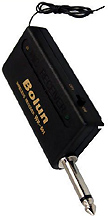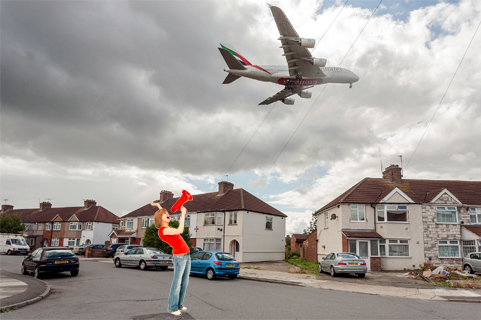Saturday 31 August, 2013, 15:07 - Spectrum Management
 According to an article in the Daily Mail, a funeral taking place in Windsor, direcly under the flightpath for aircraft landing at London Heathrow airport was interrupted by the voice of a stewardess coming over the church's public address PA system saying, "fasten your seatbelts", and, "prepare the doors for landing".
According to an article in the Daily Mail, a funeral taking place in Windsor, direcly under the flightpath for aircraft landing at London Heathrow airport was interrupted by the voice of a stewardess coming over the church's public address PA system saying, "fasten your seatbelts", and, "prepare the doors for landing".The article claims that this occured because the 'church's wireless microphone and the plane's radio were on the same frequency'. Radio microphones in the UK operate in a variety of frequency bands. Most commonly they operated between 173.1 to 175 MHz and 863 to 865 MHz, both of which are available on a licence-exempt basis for such purposes. There are other frequencies available but these are subject to the need for a licence and are only normally used for professional programme making and special event (PMSE) uses. Most domestic and everyday business use (including local DJs, schools, hotels and churches) use the licence-exempt channels.
So how could the church's radio microphone be operating on the same frequency as an aircraft? If this is true, there are two possibilities:
- The systems on-board the aircraft used the same licence-exempt frequencies that the church's radio microphone used. Or
- The radio microphone system being used by the church was not on the officially sanctioned frequencies but was operating on frequencies reserved for aeronautical communications.
The CEPT has considered the use of short-range devices on board aircraft and it has concluded that, from the regulatory perspective, such use is allowed under the same conditions provided in the relevant Annex of Recommendation 70-03. For aviation safety aspects, the CEPT is not the right body to address this matter which remains the responsibility of aircraft manufacturers or aircraft owners who should consult with the relevant national or regional aviation bodies before the installation and use of such devices on board aircraft.
So it would not be illegal for an aircraft manufacturer to use licence-exempt wireless microphones on-board their planes. There is also increasing interest in using wireless technology to control the actual flight of the aircraft (the ailerons, flap, engines and so on). Planes using 'fly-by-wireless' technology have already been tested and there are now moves to try and find dedicated spectrum for them to operate in. This negates the need for the usual wiring that is required and saves weight which in turn saves fuel and cost.
 Looking at the second possibility, there are radio microphones on the market which operate in the aeronautical communications (VHF) band from 108 to 137 MHz. These devices, commonly imported from China, are available on internet outlets at very low cost (check the frequency range on this microphone for example). They are, of course, completely illegal to use and not only are they subject to the kind of interference from aircraft that would have caused the problem in our church above, but they also have the potential to cause interference to air-to-ground aircraft communications which is stupid and potentially life-threatening. However despite such devices being available, this scenario is much less likely because the stewardess's voice would not be transmitted on the air-to-ground communication frequencies which are for pilot and air traffic controller communications only.
Looking at the second possibility, there are radio microphones on the market which operate in the aeronautical communications (VHF) band from 108 to 137 MHz. These devices, commonly imported from China, are available on internet outlets at very low cost (check the frequency range on this microphone for example). They are, of course, completely illegal to use and not only are they subject to the kind of interference from aircraft that would have caused the problem in our church above, but they also have the potential to cause interference to air-to-ground aircraft communications which is stupid and potentially life-threatening. However despite such devices being available, this scenario is much less likely because the stewardess's voice would not be transmitted on the air-to-ground communication frequencies which are for pilot and air traffic controller communications only.So it seems that it was probably the use of licence-excempt frequencies for short-range audio communications on-board the aircraft that was the culprit. It's worth considering that interference is usually bi-directional, especially where the systems are using similar powers and modulation. So it is just as likely that passengers on-board the aircraft could have been subject to the eulogy being given from the church as vice versa.
Which opens up a completely legal but very naughty set of ruses that anyone with suitable equipment could carry out if particularly bored on, say, a Sunday afternoon. Just stand near the end of the runway at an airport with a completely legal radio microphone operating, most likely, on the 863 to 865 MHz band and pick yourself a channel. As each aircraft comes overhead shout 'Brace, brace, brace' and if the aircraft's on-board wireless audio system happens to be on the same channel as your microphone the passengers are going to go ape. Of course, Wireless Waffle would never condone such activity, but if aircraft manufacturers are going to use licence-exempt frequencies, which are subject to no protection from interference, for on-board communications they are opening themselves up to all manner of prankery. If they choose to use bluetooth to actually control the aircraft itself, heavens only knows what might happen. Perhaps it would be best to stick to using wires or even optic fibre for controlling aircraft.

